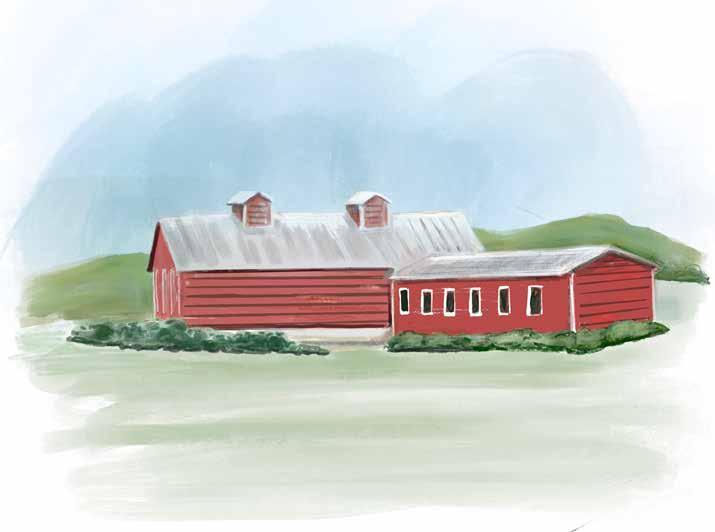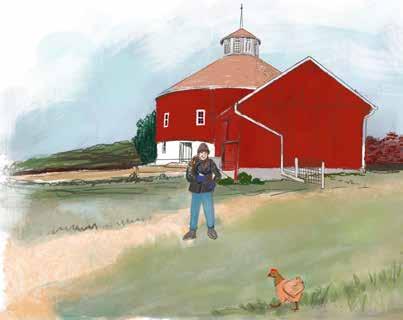
4 minute read
BARNS AND THE HISTORY THEY HOLD
by Hannah Wente
Illustrations by Cricket Redman
Advertisement
Barns are all over the southwestern Wisconsin countryside. Some have histories dating back over 150 years and are still in use today—serving as time capsules of our state’s early farming practices and people.
At the same time, we don't want to ignore the harsher realities of this history. We recognize that land deeds given throughout our state's history were for land that was stolen from the Ho-Chunk (Winnebago), Potawatomi, and Ojibwe nations through unjust treaties and forced removal. They are the true owners of this land.
Spooner’s Swan Creek Farm, also known as the Nicholas Haight Farmstead
2733 County Highway MM, Fitchburg
Edwin and Sarah Spooner of Massachusetts bought this farm in 1852, with the Haight family eventually settling on the property in 1867. The barn dates back to the 1850s and is a transverse crib barn. This timber structure’s upper floor held feed and the lower floor had animal pens. Its unique gable roof has wooden shingles and a long slope that ends at shoulder height .
“Saving our structures and site preserves a piece of our community’s heritage,” writes current owner Michael Croft. The barn is visible from County Highway MM.
John Fritz Farmstead
642 Fritz Road, Montrose
This four-bay basement, or bank, barn was built in the 1870s. Local sandstone was used to build its stone foundation. It was built into the side of a hill with a ramp to easily access both levels. Originally built to store and thresh wheat, it was later converted into a dairy barn. The lower level was used for animals and the upper level for feed.
Adam Fritz was born in Kindenheim, Bavaria in 1826. At this time, about 25 percent of immigrants to the U.S. were from Germany–many of them peasant farmers and craftsmen. Fritz immigrated to New York at age 10, and when he was 23 years old he moved to Primrose, Wisconsin to start a farm with his family. In 1850, he bought 200 acres in Montrose, eventually selling butter, oats and potatoes in Belleville and Paoli.
Bedrud-Olson Farmstead
996 E. Church Road, Town of Christiana
This 3½-story, gabled dairy barn with a timber frame and stone basement was built in 1883. The barn has one of the earliest aboveground silos in Wisconsin (which later became common for winter feed storage). Three tobacco sheds built between 1880 and 1890 are also on the property – combining tobacco and dairy production was common in Norway, and brought to this area.
Tosten Lieberson Bedrud and Christie Gunderson Vossolt were among the first wave of Norwegian immigrants to settle near Lake Koshkonong in 1844. Originally, they lived in a dugout house and the farm’s 120 acres were used for subsistence and wheat farming.

After the Civil War, demand for wheat declined while demand for cheese and butter increased, creating a need for a place to store hay and milk cows. In 1906, the Olson family (Bedrud’s granddaughter Anna and husband Anton Olson) worked 100 of the 156 acres—15 for tobacco production and the remainder for crops like corn and hay. Anna’s sons Henry and Martin bought the farm in 1918 and farmed until 1976 when it was sold to a neighbor. Tobacco production continues on the property today.
Ten Eyck Orchard
W968 State Highway 11, Brodhead
The Ten Eyck barn has been in the same family and used on a working farm for just over a century. All the lumber made to build this barn in 1922 was cut from the surrounding area, then steamed and bent into curves to create the round shape. Everything but the mortar and bricks is local to the property.
The Ten Eyck family emigrated from the Netherlands to New Amsterdam (present-day Manhattan) in the 1630s. In 1839, Jacob Ten Eyck and his wife, Rachel, became two of the first European-American settlers in Green County. Jacob’s grandson was one of the first four students in the Department of Agriculture/ Agronomy at UW–Madison and convinced the family to plant apple trees on their farm.
Drew Ten Eyck is the sixth generation to work the farm. Sixteen acres house 10,000 fruit trees, including 50 kinds of apples, peaches and plums. Ten Eyck Orchard is open a week before Labor Day through the weekend before Thanksgiving.
Botham Vineyards & Winery
8180
Langberry Road, Barneveld
This dairy barn, built in 1904, had a large hay mow and broad oak beams across the length of the building. The limestone for its foundation and the wood for construction were harvested from the surrounding property. Structurally, the barn is supported via an arch instead of posts, leaving the inside space more open.
The farm transitioned from dairy to beef cattle in the 1960s. In 1989, Peter Botham bought the 40-acre property from his dad and planted an estate vineyard on 10 acres. In 1991, the barn was painted and a new roof was added. A tasting room for Botham Vineyards & Winery opened in 1994, using half the barn’s main floor. The other half of the restored barn is used to host weddings and events.
The tasting room is open through October, Friday to Sunday from 11 a.m. to 5 p.m. It’s open November through December, Saturday and Sunday from 11 a.m. to 5 p.m.
Schuster’s Farm
1326
US 12/18, Deerfield
The barn at Schuster's Farm was built in 1901 by Lewis Lendborg, a Scandinavian carpenter from Cottage Grove. Built for the Gangstad family, the barn was designed by Professional Franklin H. King nearby. Built for the Gangstad family, the barn was originally used for dairy cows and it still holds animals to this day. It had a louvered round cupola that was removed following a lightning storm. Its design signals scientific progress in the dairy industry with a central silo to prevent feed from freezing, as well as improved ventilation and thick limestone walls that were more efficient, wind-resistant and easier to build than timber-heavy barns. A hay chute in the center made it easier to push feed in front of cows.
In 1968, the Gangstads sold their dairy herd and transitioned it from a dairy barn to a pig barn, converting two dozen stanchions into space for 125 pigs. Today, Schuster’s Farm is a destination for hands-on farm activities like petting zoos and pick-your-own pumpkins. In 2001, owners Don and Sarah Schuster undertook a renovation, including milling oak trees from the farm to replace posts and the oak plank floor in the haymow.
If you decide to visit any of these barns, please remember that many are on private property, so please view respectfully from public property.









